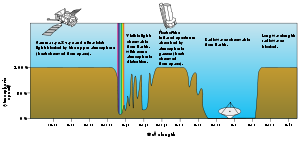
Optical window
Encyclopedia

- In astronomyAstronomyAstronomy is a natural science that deals with the study of celestial objects and phenomena that originate outside the atmosphere of Earth...
, the optical window is the optical portion of the electromagnetic spectrumElectromagnetic spectrumThe electromagnetic spectrum is the range of all possible frequencies of electromagnetic radiation. The "electromagnetic spectrum" of an object is the characteristic distribution of electromagnetic radiation emitted or absorbed by that particular object....
that passes through the atmosphereEarth's atmosphereThe atmosphere of Earth is a layer of gases surrounding the planet Earth that is retained by Earth's gravity. The atmosphere protects life on Earth by absorbing ultraviolet solar radiation, warming the surface through heat retention , and reducing temperature extremes between day and night...
all the way to the ground. Most EM wavelengths are blocked by the atmosphere, so this is like a window that lets through only a narrow selection of what is out there, though the Sun is particularly active in the passed wavelengths. It is called "optical" because the wavelengths we can see are all in this range. The window runs from around 300 nanometers (ultravioletUltravioletUltraviolet light is electromagnetic radiation with a wavelength shorter than that of visible light, but longer than X-rays, in the range 10 nm to 400 nm, and energies from 3 eV to 124 eV...
-C) at the short end up into the range the eye can use, roughly 400-700 nm and continues up through the visual infraredInfraredInfrared light is electromagnetic radiation with a wavelength longer than that of visible light, measured from the nominal edge of visible red light at 0.74 micrometres , and extending conventionally to 300 µm...
to around 1100 nm, which is thermal infrared. There are also infrared and "radio windowRadio windowThe radio window is the range of frequencies of electromagnetic radiation that the earth's atmosphere lets through. The wavelengths in the radio window run from about one centimetre to about eleven-metre waves.-See also:*Astronomical window...
s" that transmit some infraredInfraredInfrared light is electromagnetic radiation with a wavelength longer than that of visible light, measured from the nominal edge of visible red light at 0.74 micrometres , and extending conventionally to 300 µm...
and radio wavesRadio wavesRadio waves are a type of electromagnetic radiation with wavelengths in the electromagnetic spectrum longer than infrared light. Radio waves have frequencies from 300 GHz to as low as 3 kHz, and corresponding wavelengths from 1 millimeter to 100 kilometers. Like all other electromagnetic waves,...
. The radio window runs from about one centimeter to about eleven-meter waves.
- In medical physicsMedical physicsMedical physics is the application of physics to medicine. It generally concerns physics as applied to medical imaging and radiotherapy, although a medical physicist may also work in many other areas of healthcare...
, the optical window is the portion of the visible and infrared spectrum where living tissue absorbs relatively little light. This window runs approximately from 650 nm to 1200 nm. At shorter wavelengths light is strongly absorbed by hemoglobinHemoglobinHemoglobin is the iron-containing oxygen-transport metalloprotein in the red blood cells of all vertebrates, with the exception of the fish family Channichthyidae, as well as the tissues of some invertebrates...
in blood, while at longer wavelengths water strongly absorbs infrared light.
- In optics, it means a (usually at least mechanically flatFloat glassFloat glass is a sheet of glass made by floating molten glass on a bed of molten metal, typically tin, although lead and various low melting point alloys were used in the past. This method gives the sheet uniform thickness and very flat surfaces. Modern windows are made from float glass...
, sometimes optically flatOptical flatOptical flats are optical-grade pieces of glass lapped and polished to be extremely flat on one or both sides, usually within a few millionths of an inch . They are used with a monochromatic light to determine the flatness of other optical surfaces by interference...
, depending on resolution requirements) piece of transparent (for a wavelength range of interest, not necessarily for visible light) optical material that allows light into an optical instrumentOptical instrumentAn optical instrument either processes light waves to enhance an image for viewing, or analyzes light waves to determine one of a number of characteristic properties.-Image enhancement:...
. A window is usually parallel and is likely to be anti reflection coatedAnti-reflective coatingAn antireflective or anti-reflection coating is a type of optical coating applied to the surface of lenses and other optical devices to reduce reflection. This improves the efficiency of the system since less light is lost. In complex systems such as a telescope, the reduction in reflections also...
, at least if it is designed for visible light. An optical window may be built into a piece of equipment (such as a vacuum chamberVacuum chamberA vacuum chamber is a rigid enclosure from which air and other gases are removed by a vacuum pump. The resulting low pressure, commonly referred to as a vacuum, allows researchers to conduct physical experiments or to test mechanical devices which must operate in outer space...
) to allow optical instruments to view inside that equipment.

